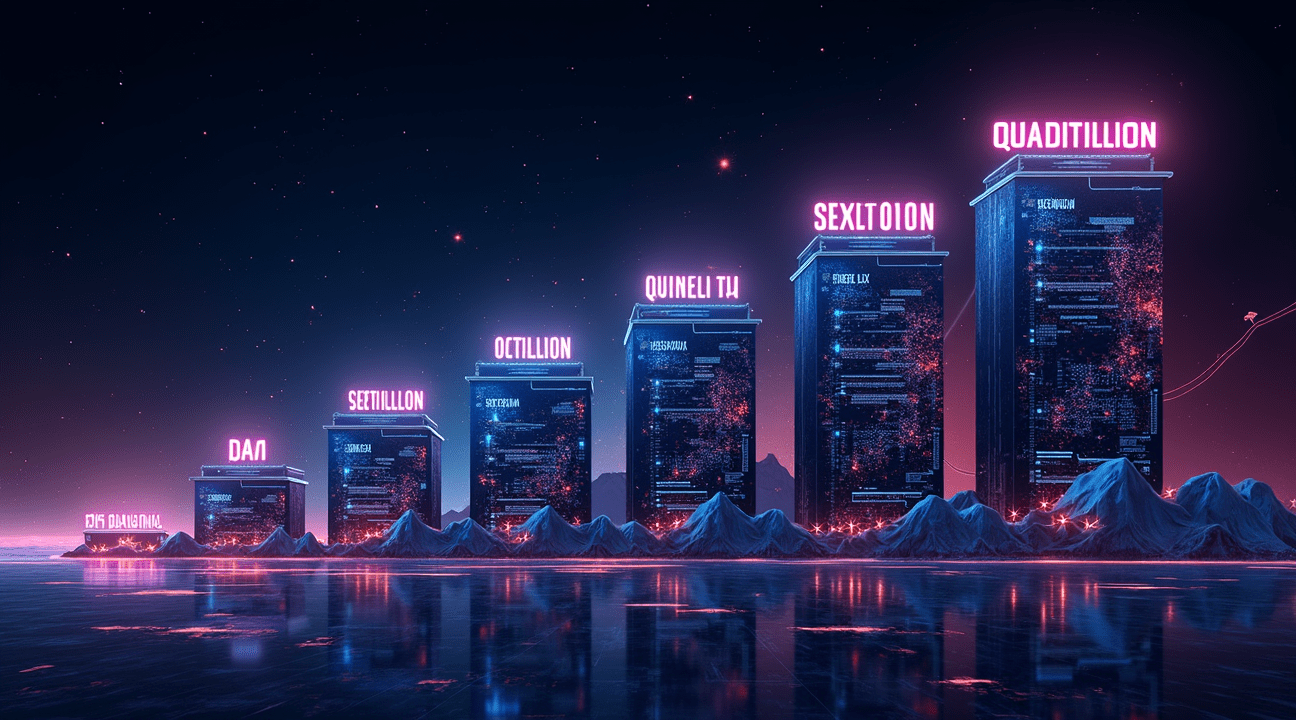Astronomical wealth categories extend far beyond quadrillionaire status, creating mathematical progressions that completely overshadow current global economics.
Wealth Beyond Quadrillions
Quintillionaires possess $1,000,000,000,000,000,000 (10¹⁸), which is 1,000 times more than a quadrillionaire — a level of wealth that completely eclipses today’s global economy. The exponential nature of this wealth follows the short scale naming system, where each new tier multiplies the previous by 1,000.
Mathematical Wealth Tiers
Here are some notable tiers in computational or theoretical wealth:
- Quintillionaire: $1 quintillion (10¹⁸) – 1,000 times the wealth of a quadrillionaire.
- Sextillionaire: $1 sextillion (10²¹) – equivalent to millions of Earth-sized economies.
- Septillionaire: $1 septillion (10²⁴) – an amount that would dwarf most human concepts of value.
- Octillionaire and beyond: Haywire levels of wealth such as $1 octillion (10²⁷) escalate without tangible reference in real-world terms.
From this point, numbers become purely academic or theoretical rather than economically feasible.
Googol Wealth and Beyond
A googol represents the number 10¹⁰⁰, which far exceeds the number of atoms in the observable universe. Even more abstract is Graham’s number, which soars past a googol and enters realms of numbers beyond human comprehension. These figures serve as mathematical concepts rather than as plausible economic milestones.
Theoretical Not Practical
Not one individual on Earth currently possesses quadrillionaire-level wealth. Global wealth is estimated at approximately $400–500 trillion. Therefore:
- Quintillionaires do not exist – today’s wealth distribution makes such status impossible.
- Resource constraints impose real limits – Earth’s physical materials and energy capacity cap potential wealth.
- Wealth increases are bound by real economies – no economic systems currently known can support these figures.
Educational Significance
These extreme levels of hypothetical wealth serve educational purposes by:
- Demonstrating exponential growth in understandable terms.
- Visualizing scale differences between values like million, billion, and beyond.
- Highlighting abstraction of massive numbers in mathematics versus their grounded applicability.
Frequently used in academic settings, these examples teach valuable lessons about numerical literacy, helping learners grasp the concept of scaling and the limitations of real-world finance.
Conclusion
The divide between theoretical wealth categories like sextillionaire and googol-aire and economic reality underlines the conceptual difference between mathematics and practical economics. While numbers can grow infinitely, real-world wealth accumulation is constrained by physical and systemic boundaries. These mathematical progressions help visualize exponential concepts and emphasize the limits of our economic understanding when faced with the sheer potential magnitude of large numbers.
Beyond Quadrillion: Quintillionaire and Higher Wealth Classes
I find it fascinating to consider what lies beyond the astronomical wealth of quadrillionaires. The mathematical progression of extreme wealth continues far beyond what most people can even imagine, reaching into numerical territories that dwarf current global economies.
A quintillionaire would possess an incredible 1,000,000,000,000,000,000 dollars (10¹⁸), making them exactly 1,000 times wealthier than even a quadrillionaire. I can barely comprehend such figures, yet the progression doesn’t stop there. A sextillionaire would command 1,000,000,000,000,000,000,000 dollars (10²¹), representing wealth so vast it becomes exponentially greater than any current billionaire’s net worth.
The Astronomical Wealth Progression
I’ve studied how these wealth classes expand using the short scale system, where each level multiplies the previous by a thousand. Consider these mind-boggling categories:
- Septillionaire: 1,000,000,000,000,000,000,000,000 dollars (10²⁴)
- Octillionaire: 1,000,000,000,000,000,000,000,000,000 dollars (10²⁷)
- Nonillionaire: 1,000,000,000,000,000,000,000,000,000,000 dollars (10³⁰)
- Decillionaire: 1,000,000,000,000,000,000,000,000,000,000,000 dollars (10³³)
Each wealth class represents a thousand-fold increase from its predecessor, creating powers of ten that quickly spiral into incomprehensible territory. I find it remarkable that while Elon Musk gains Twitter and similar high-profile acquisitions make headlines, they pale compared to these theoretical wealth levels.
The progression continues indefinitely through mathematical nomenclature – undecillionaire, duodecillionaire, and beyond. I recognize that such wealth levels exist purely in theoretical discussion, as they far exceed the total value of all assets, currencies, and economic activity on Earth. Even MrBeast restores sight to thousands through his charitable work, demonstrating how current mega-wealth can create massive positive impact – imagine the potential influence of quintillionaire-level resources.
These astronomical figures serve more as mathematical exercises than realistic wealth targets. I appreciate how they help illustrate the exponential nature of large-scale mathematics and provide perspective on just how extreme wealth accumulation could theoretically become. The concept challenges our understanding of value itself when numbers become so large they transcend practical economic meaning.
The Mind-Bending Scale: Googol Wealth and Beyond
I find myself staggered when considering wealth levels that transcend even quadrillionaire status. The concept of googol wealth represents a mathematical impossibility that challenges our understanding of value itself. A googol equals 10¹⁰⁰, which translates to a 1 followed by 100 zeros—an astronomical figure that makes a quadrillion look microscopic by comparison.
Understanding Googol Numbers
When I contemplate the sheer magnitude of a googol, the number becomes almost incomprehensible. Scientists estimate the observable universe contains roughly 10⁸⁰ atoms, yet a googol dwarfs even this cosmic inventory. A person possessing googol dollars would theoretically control wealth that exceeds the total atomic structure of everything we can observe in space.
The googolplex pushes these boundaries even further into impossible territory. This number equals 10^(10¹⁰⁰), or a 1 followed by a googol zeros. I can’t emphasize enough how this number transcends human comprehension—if someone attempted to write out a googolplex, they’d need more space than exists in our entire universe just to record the zeros.
Why Googol Wealth Remains Purely Theoretical
These wealth levels exist only in mathematical theory because physical reality imposes hard limits. I recognize that wealth ultimately represents claims on real resources, goods, and services. The entire gross domestic product of Earth measures in the trillions, making even quadrillionaire status practically impossible with current global economics.
Consider this perspective: a googolplex relates to a quadrillion the same way a quadrillion relates to a single penny, but exponentially more extreme. Just as major entrepreneurs push boundaries in accumulating billions, the leap from billions to googol wealth spans dimensions that physics itself cannot accommodate.
I understand that discussing these theoretical wealth levels serves an important purpose in demonstrating the limits of mathematical possibility versus economic reality. While innovators continue creating value through revolutionary technologies and transformative initiatives, even the most successful ventures cannot approach googol-level accumulation.
The observable universe simply doesn’t contain enough matter, energy, or resources to support such theoretical wealth. These numbers remain fascinating mathematical constructs that help illustrate the incredible scales possible in pure mathematics while highlighting the fundamental constraints that govern real-world economics and resource distribution.

Breaking Down the Numbers: From Quadrillion to Infinity
A quadrillion represents a staggering number: 1,000,000,000,000,000 or 1 followed by 15 zeros. This massive figure holds significance as 10¹⁵ in scientific notation, making it one thousand times larger than a trillion. In short scale countries like the US and UK, mathematicians and economists define a quadrillion as a thousand trillion, which helps put this astronomical figure into perspective.
Understanding the Numerical Progression Beyond Quadrillion
The prefix ‘peta-‘ represents this immense scale in various scientific contexts, particularly when measuring massive data storage in petabytes or astronomical distances in petameters. I’ve compiled a progression table that illustrates the mind-bending climb from quadrillion into even more extraordinary territories:
- Quadrillion: 10¹⁵ (15 zeros)
- Quintillion: 10¹⁸ (18 zeros)
- Sextillion: 10²¹ (21 zeros)
- Septillion: 10²⁴ (24 zeros)
- Octillion: 10²⁷ (27 zeros)
Each step up this numerical ladder represents a multiplication by 1,000, creating wealth levels that become increasingly theoretical rather than practical. While a quadrillionaire’s fortune would already dwarf entire national economies, a quintillionaire would possess wealth exceeding the combined GDP of all nations combined multiple times over.
Modern technology offers fascinating parallels to these enormous numbers. Elon Musk’s business ventures and other tech innovations demonstrate how exponential growth can push valuations into previously unimaginable territories. Scientific notation becomes essential when dealing with such massive figures, as writing out octillion in standard form would require 28 digits.
Financial theorists and mathematicians often use these enormous numbers to model hypothetical scenarios involving hyperinflation, universal basic income calculations, or interplanetary economic systems. Revolutionary technologies could theoretically create new markets valued in these extreme ranges.
The concept transcends mere mathematics when considering what true wealth beyond a quadrillion might represent. Instead of focusing solely on monetary accumulation, these figures force us to reconsider value itself. Resources, knowledge, time, influence, and technological capabilities might become more meaningful measures than traditional currency when dealing with such astronomical wealth levels.

Mathematical Giants: Numbers That Defy Comprehension
While quadrillionaires represent an astronomical level of wealth, the mathematical universe contains numbers so staggeringly large they make even quadrillions appear microscopic. Graham’s number stands as perhaps the most famous example of these incomprehensible mathematical monsters. Developed by mathematician Ronald Graham, this number serves as an upper bound in certain combinatorial problems and is so enormous that writing it down would require more space than exists in the observable universe.
Graham’s number operates on an entirely different scale than conventional numerical understanding. Even if someone could write one digit on every atom in the known cosmos, they still wouldn’t have enough space to express Graham’s number in standard notation. This figure dwarfs a googolplex, which itself is already unimaginably vast at 10^(10^100). The comparison between Graham’s number and a googolplex is like comparing the size of the entire universe to a single subatomic particle.
Beyond Graham’s Number: Other Mathematical Titans
Skewes number represents another colossal figure in pure mathematics, arising from prime number theory research. Originally calculated as approximately 10^10^10^34, this number helped establish bounds in certain mathematical proofs. Just as innovative entrepreneurs push boundaries in technology and business, mathematicians use these enormous numbers to push the limits of human understanding.
Several other theoretical numbers exist that challenge comprehension:
- Tree(3) – A number arising from graph theory that makes Graham’s number look infinitesimal
- SSCG(3) – Another function-based number that grows at an incomprehensible rate
- Rayo’s number – Defined as the smallest number bigger than any finite number named by an expression in first-order set theory
These theoretical numbers serve specific purposes in mathematical proofs and advanced research. Unlike the systematic progression of standard large numbers, they don’t follow predictable patterns. They exist as upper bounds, proof tools, or examples of mathematical extremes rather than practical measurements.
The standard naming system for large numbers follows a more orderly progression that mathematicians and scientists can actually use. After quadrillion comes quintillion (10^18), followed by sextillion, septillion, and octillion. This pattern continues through novemdecillion (10^60) and vigintillion (10^63), eventually reaching centillion at 10^303 in the short scale system used in most English-speaking countries.
Each step in this naming sequence adds three zeros, making the progression predictable and manageable for scientific calculations. Astronomers might discuss distances in sextillions of miles, while particle physicists work with septillions of atomic interactions. These numbers, while enormous, remain within the bounds of practical scientific application.
The mathematical giants like Graham’s number exist in an entirely different category. They emerge from pure mathematical research where the goal isn’t practical application but rather understanding the fundamental limits of logical systems. These numbers help mathematicians explore questions about infinity, computability, and the nature of mathematical truth itself.
Understanding these numerical behemoths provides perspective on what truly constitutes “large” in mathematical terms. While a quadrillionaire possesses wealth beyond most people’s imagination, the mathematical universe contains numbers that make quadrillions seem laughably small. Revolutionary innovations in computing and technology continue advancing our ability to work with larger numbers, yet these mathematical giants remain far beyond any practical calculation.
Graham’s number and its mathematical cousins serve as reminders that human intuition about size and scale breaks down completely when confronting the infinite possibilities of pure mathematics. They represent the ultimate expression of abstract thinking, existing not as measures of physical reality but as monuments to the power of mathematical reasoning to transcend all earthly limitations.
https://www.youtube.com/watch?v=HXTJQ8WSxZw

Reality Check: The Impossibility of Extreme Wealth
I’ve examined the current state of global wealth distribution, and the reality is striking: no individual possesses wealth anywhere close to a quadrillion dollars. The term “quadrillionaire” remains purely theoretical in today’s economic landscape, as even the wealthiest individuals fall dramatically short of this astronomical figure.
Elon Musk and other billionaires represent the pinnacle of personal wealth accumulation, yet their fortunes pale in comparison to quadrillion-dollar amounts. Global wealth estimates place total worldwide assets at approximately $400–500 trillion, meaning a single quadrillionaire would control roughly 0.2–0.25% of all wealth on Earth.
Beyond Quadrillions: Understanding Quintillionaires
When I consider what surpasses quadrillionaire status, the answer leads to quintillionaires—individuals who would theoretically possess 1,000 times more wealth than quadrillionaires. These astronomical wealth levels exist only in hypothetical scenarios that would require fundamental shifts in economic systems or currency values.
Several conditions could theoretically produce such extreme wealth concentrations:
- Hyperinflation scenarios where currency values deteriorate rapidly
- Complete economic system overhauls that concentrate assets differently
- Technological breakthroughs that create unprecedented value accumulation
- Resource discoveries or control that dwarf current understanding
Hyperinflation presents the most realistic path for these wealth levels to emerge numerically. Countries experiencing severe currency devaluation have seen individuals become “billionaires” or “trillionaires” in local currency while possessing relatively modest real purchasing power. Zimbabwe’s economic collapse created similar nominal wealth figures without corresponding real value increases.
I recognize that these theoretical wealth ranges stretch beyond practical economic reality. Quintillionaire status would require controlling assets equivalent to multiple times the current global economy’s total output. Such concentration would fundamentally alter economic systems and likely prove unsustainable within existing frameworks.
The mathematical progression continues beyond quintillionaires to sextillionaires, septillionaires, and higher orders of magnitude. Each level represents another thousandfold increase from the previous tier, creating wealth concentrations that become increasingly divorced from economic reality.
Current wealth inequality discussions focus on billionaires and their impact on society and economics. MrBeast’s philanthropic efforts demonstrate how even smaller fortunes can create significant social impact, highlighting the disconnect between theoretical extreme wealth and practical application.
Global wealth distribution patterns suggest that quadrillionaire-level accumulation would require capturing substantial portions of entire nations’ economic output. I observe that such concentration would likely trigger systemic economic responses, regulatory interventions, or social upheavals that would redistribute assets before reaching these theoretical levels.
The practical impossibility of extreme wealth accumulation stems from several factors. Economic systems naturally create resistance to unlimited concentration through market forces, regulatory frameworks, and social pressures. Additionally, maintaining liquidity and value across such massive asset portfolios would present unprecedented logistical challenges.
Technological advancement could theoretically create new wealth categories through revolutionary discoveries or innovations. Flying car technology and similar breakthroughs might generate substantial value, but even transformative innovations would struggle to reach quadrillion-dollar valuations without broader economic expansion.
I find that discussions about hypothetical wealth levels beyond quadrillionaires serve primarily as thought experiments rather than realistic projections. These scenarios help illustrate the scale of current wealth inequality while highlighting the practical limits of asset concentration within existing economic structures.
The conversation about extreme wealth ultimately returns to questions of economic sustainability, social responsibility, and resource distribution. Whether examining quadrillionaires or quintillionaires, these wealth levels represent concentrations that would fundamentally challenge current understanding of economics and society.
Understanding the Scale Systems and Practical Applications
The short scale system fundamentally shapes how I understand massive wealth figures in the United States and United Kingdom. This system operates on a simple principle: each successive named number increases by exactly 1,000 times the previous value. Starting with a million (1,000,000), a billion becomes 1,000 million, a trillion equals 1,000 billion, and a quadrillion reaches 1,000 trillion.
This differs dramatically from the long scale system used in many European countries, where each new term multiplies the previous by one million instead of one thousand. Under the long scale, what Americans call a billion (1,000,000,000) would actually be called a milliard, while their billion equals what Americans term a trillion.
Breaking Down the Numbers
These scale differences create fascinating scenarios when I examine extreme wealth levels. A quadrillionaire under the short scale possesses $1,000,000,000,000,000 — that’s fifteen zeros following the one. To put this in perspective, consider these practical comparisons:
- The entire global GDP hovers around $100 trillion annually, making a quadrillionaire worth ten times the world’s total economic output.
- Elon Musk’s wealth at its peak reached roughly $300 billion, meaning a quadrillionaire would possess over 3,000 times that amount.
- The total value of all U.S. real estate sits at approximately $40 trillion, making a quadrillionaire worth 25 times the entire American property market.
- All the gold ever mined throughout human history has a value of about $12 trillion, making our theoretical quadrillionaire worth roughly 83 times that precious metal stockpile.
Moving beyond quadrillionaire status introduces quintillions ($1,000,000,000,000,000,000), sextillions, and eventually numbers so large they lose practical meaning in earthly contexts. A quintillionaire would possess wealth equivalent to 10,000 times the global economy, entering territory where such figures become purely theoretical exercises.
I find that comparing these astronomical numbers to familiar concepts helps grasp their true magnitude. If someone spent $1 million every single day, it would take them over 2.7 million years to spend a quadrillion dollars. Even at the extravagant rate of $1 billion daily, depleting a quadrillion would require nearly 2,740 years of continuous spending.
The practical applications of understanding these scale systems extend beyond wealth discussions. Scientific measurements, technological capacities, and even entertainment industry valuations increasingly reference these massive numbers. When content creators discuss massive subscriber counts or sports partnerships involve enormous figures, the same scaling principles apply.
Technology companies particularly benefit from this understanding when discussing data storage capacities, processing speeds, or user engagement metrics. A quintillion bytes (one exabyte) represents standard measurements in modern data centers, while entertainment companies like Disney manage intellectual property portfolios worth hundreds of billions.
These scale systems also prove crucial when analyzing theoretical future scenarios. Advanced transportation technologies or futuristic entertainment platforms might eventually create new categories of wealth that surpass current billionaire status.
Economic modeling relies heavily on these consistent scaling relationships to predict market behaviors, inflation impacts, and wealth distribution patterns. Without standardized understanding of these progressions, international financial communications would become impossibly complex.
The key insight remains that while quadrillionaire status represents unfathomable wealth by today’s standards, the mathematical frameworks exist to describe even larger accumulations. Each step up the scale system maintains logical progression, even when the resulting figures stretch far beyond current economic reality.
Sources:
Beyond Quadrillion: Quintillionaire and Higher Wealth Classes
The Mind-Bending Scale: Googol Wealth and Beyond
Breaking Down the Numbers: From Quadrillion to Infinity
Mathematical Giants: Numbers That Defy Comprehension
Reality Check: The Impossibility of Extreme Wealth
Understanding the Scale Systems and Practical Applications


